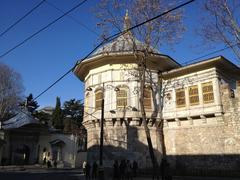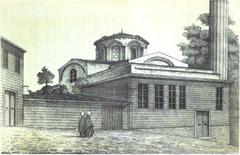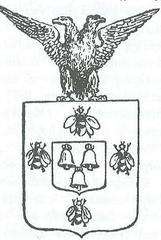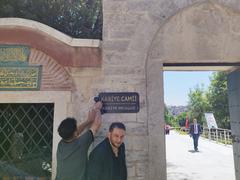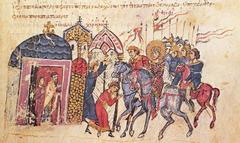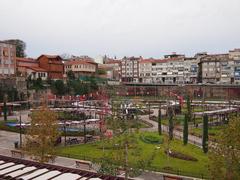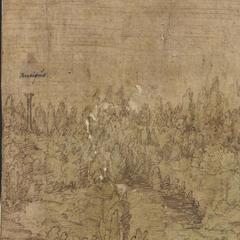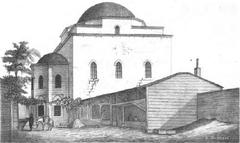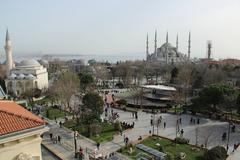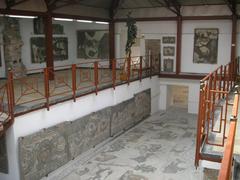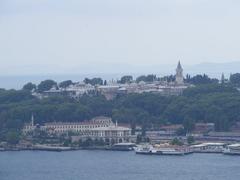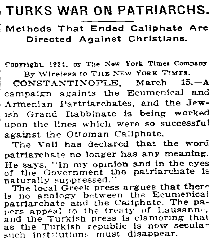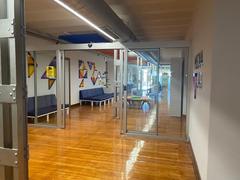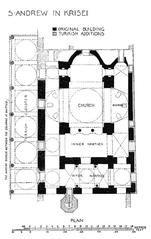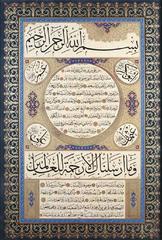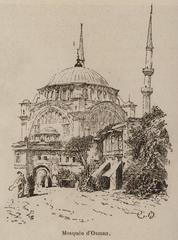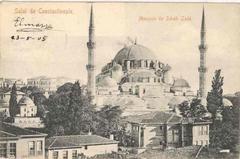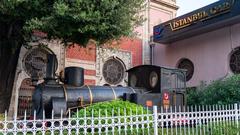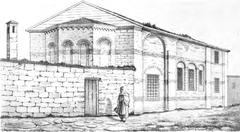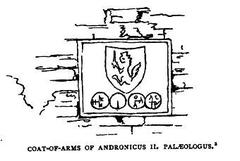Rüstem Pasha Medrese: Visiting Hours, Tickets, and Historical Significance in Fatih, Turkey
Date: 03/07/2025
Introduction
The Rüstem Pasha Medrese, nestled within Istanbul’s storied Fatih district, stands as a distinguished monument of Ottoman educational, architectural, and cultural heritage. Commissioned by Rüstem Pasha—grand vizier and son-in-law to Sultan Süleyman the Magnificent—in the 16th century, the medrese was masterfully designed by the renowned architect Mimar Sinan (Istanbul Historical Sites). As a vibrant center for Islamic learning, the medrese is also celebrated for its harmonious classical Ottoman architecture and the dazzling İznik tilework adorning its interiors (Turkish Cultural Foundation). Today, it remains a beacon of cultural continuity, offering visitors a well-preserved glimpse into Istanbul’s intellectual and artistic legacy.
This comprehensive guide explores the medrese’s origins, architectural features, visitor information—including free admission and opening hours—accessibility, nearby attractions, and practical tips. Whether your interest lies in history, architecture, or immersive travel, Rüstem Pasha Medrese offers a rewarding experience at the heart of Istanbul’s heritage.
Table of Contents
- Introduction
- Historical Context
- Rüstem Pasha: The Patron
- Architectural and Artistic Heritage
- Educational and Cultural Role
- Visitor Information
- Nearby Attractions
- Educational Programs and Events
- Preservation Efforts
- Visuals and Media
- Frequently Asked Questions (FAQ)
- Conclusion
- Sources and Further Reading
Historical Context
Commissioned between 1550 and 1551 by Rüstem Pasha, a statesman famed for his administrative reforms and philanthropic vision, the medrese was constructed under the direction of Mimar Sinan, the Ottoman Empire’s chief architect. The medrese played a pivotal role in the empire’s intellectual life, training scholars, judges, and administrators who would shape Ottoman society (Istanbul Historical Sites). Its location in Fatih—a district long associated with scholarship and religious authority—underscored its importance within the city’s educational and administrative fabric.
Rüstem Pasha: The Patron
Rüstem Pasha (c. 1505–1561) rose to prominence through the devşirme system, eventually serving as grand vizier and marrying Mihrimah Sultan, the daughter of Süleyman the Magnificent. His legacy is one of public benefaction, with significant investment in charitable and educational endowments, including medreses, mosques, and caravanserais. The Rüstem Pasha Medrese, alongside the celebrated Rüstem Pasha Mosque, stands as a testament to his enduring commitment to learning and public welfare.
Architectural and Artistic Heritage
Design and Structure
The medrese reflects the principles of classical Ottoman educational architecture: a central courtyard surrounded by domed classrooms and student cells, facilitating both communal and individual study (Istanbul Metropolitan Municipality). Mimar Sinan’s design emphasizes harmonious proportions, functional spaces, and the integration of artistic elements with educational purpose.
İznik Tilework
One of the medrese’s most distinctive features is its İznik tile decoration, renowned for vibrant cobalt blues, turquoises, and intricate geometric and floral motifs (Turkish Cultural Foundation). These tiles, masterpieces of 16th-century Ottoman ceramic art, are preserved in key interior spaces, offering a rare, in-situ glimpse of Ottoman artistic excellence.
Educational and Cultural Role
As a waqf (charitable endowment), the medrese was built to provide free education to students from diverse backgrounds, epitomizing the Ottoman commitment to accessible learning (Islamic Studies Foundation). The curriculum included religious sciences—such as Qur’anic exegesis and Islamic jurisprudence—alongside mathematics, astronomy, and philosophy. At its height, the medrese accommodated up to 30 students, each with a living and study cell, and featured a library and mosque for integrated spiritual and intellectual development (Istanbul University Research).
Today, the medrese serves as a cultural landmark and educational resource, frequently included in heritage tours, academic research, and community events (GoTurkey Tourism; Istanbul Tourism Directorate). Its proximity to the Rüstem Pasha Mosque offers visitors a cohesive ensemble of Ottoman religious and educational architecture.
Visitor Information
Visiting Hours
- Open: Tuesday–Sunday, 9:00 AM to 5:00 PM
- Closed: Mondays and major public holidays
Tickets
- Admission: Free of charge
- Donations: Welcome to support ongoing preservation
Accessibility
- The medrese offers wheelchair access to key areas; assistance is available upon request. Given the historic structure and cobblestone surroundings, visitors with mobility challenges are advised to contact the administration in advance.
Guided Tours
- Guided tours are available via local operators and the Istanbul Tourist Information Centers. These tours provide in-depth insights into the medrese’s history and architecture, often as part of broader Fatih district itineraries (Istanbul Tourist Information Centers).
Travel Tips
- Visit early to avoid crowds and enjoy optimal lighting for photography
- Wear comfortable shoes suitable for cobblestone streets
- Photography is encouraged (no flash); key areas include the courtyard and tile-adorned interiors
- Respect the quiet and contemplative atmosphere, especially during events or prayers
Nearby Attractions
- Rüstem Pasha Mosque: Famed for sublime İznik tilework, a short walk away
- Spice Bazaar (Mısır Çarşısı): A vibrant market for spices and local goods
- Fatih Mosque Complex: An architectural and religious landmark
- Grand Bazaar: One of the world’s largest and oldest covered markets
Educational Programs and Events
The medrese regularly hosts workshops on Ottoman calligraphy, tile-making, and manuscript illumination, often in collaboration with cultural foundations and universities (Yunus Emre Institute). Guided tours led by historians or art experts are available in several languages, appealing to diverse audiences including students and international visitors (Istanbul Municipality Culture Department).
Preservation Efforts
Restoration projects in recent decades have stabilized the structure, restored damaged tilework, and improved visitor amenities while maintaining historical authenticity (Turkish Ministry of Culture and Tourism). Academic research continues to enrich our understanding of the medrese’s role in Ottoman educational, architectural, and urban history (Journal of Ottoman Studies).
Visuals and Media
Visitors are encouraged to explore the medrese’s beauty through photos and virtual tours on official Istanbul cultural portals. High-resolution images—tagged with descriptive alt text such as “Rüstem Pasha Medrese İznik tilework”—allow remote or preliminary exploration, while onsite panels and digital guides enhance the visit (Istanbul Museums; Istanbul Modern).
Frequently Asked Questions (FAQ)
Q: What are the visiting hours?
A: Tuesday–Sunday, 9:00 AM–5:00 PM; closed on Mondays and public holidays.
Q: Is there an entrance fee?
A: Entry is free; donations are appreciated.
Q: Is the site wheelchair accessible?
A: Key areas are accessible; assistance is available.
Q: Are guided tours available?
A: Yes, in multiple languages, via official centers or local operators.
Q: What attractions are nearby?
A: The Rüstem Pasha Mosque, Spice Bazaar, Fatih Mosque, and Grand Bazaar.
Conclusion
Rüstem Pasha Medrese stands as a testament to the Ottoman Empire’s enduring legacy of education, architectural sophistication, and cultural generosity. Its harmonious design by Mimar Sinan, rich İznik tilework, and tranquil courtyard invite visitors to reflect on centuries of scholarly endeavor and artistic achievement. Together with the nearby Rüstem Pasha Mosque, the medrese offers a comprehensive experience of Istanbul’s layered history.
For up-to-date details, interactive guides, and curated tours, download the Audiala app and follow Istanbul’s cultural institutions on social media. Enrich your journey by participating in workshops, guided tours, or simply enjoying the peaceful ambiance of this historic site.
Sources and Official Links
- Istanbul Historical Sites
- Turkish Cultural Foundation
- Istanbul Metropolitan Municipality
- Islamic Studies Foundation
- Istanbul University Research
- GoTurkey Tourism
- Istanbul Tourism Directorate
- Yunus Emre Institute
- Istanbul Municipality Culture Department
- Turkish Ministry of Culture and Tourism
- Journal of Ottoman Studies
- Istanbul Museums
- Istanbul Modern
- Audiala
- Better Istanbul
- Istanbul Tourist Information Centers
